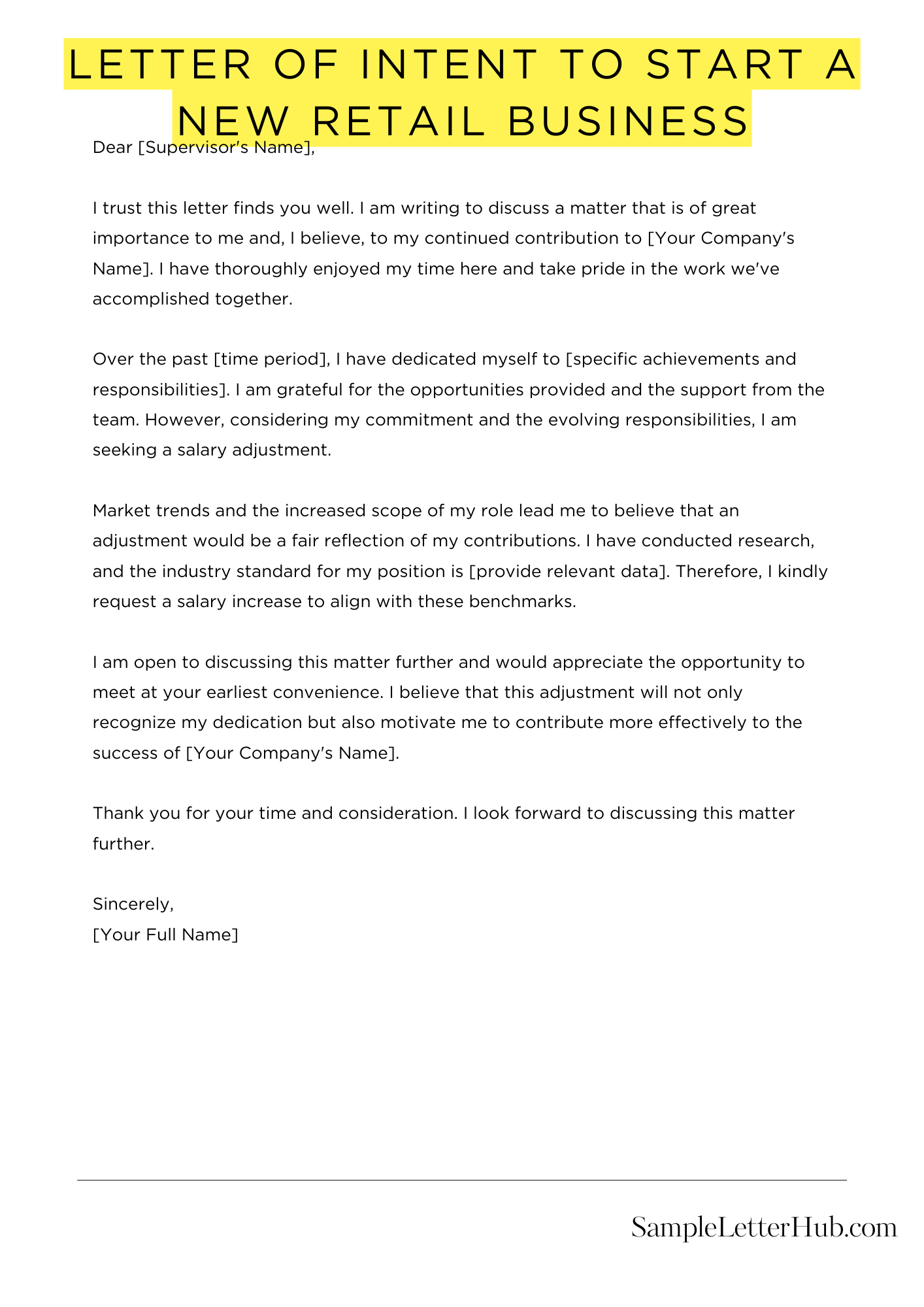A Letter Of Intent To Start A New Retail Business is a document that outlines your plans for starting a new retail business. It is typically used to secure funding from investors or lenders.
In this blog article, we will share templates, examples, and samples of Letter Of Intent To Start A New Retail Business. These templates will help you write a clear and concise letter of intent that will increase your chances of getting funding for your new business.
We will also provide tips on how to write a strong letter of intent and what to include in your letter.
Letter Of Intent To Start A New Retail Business
Dear [Recipient Name],
I am writing to express my intent to start a new retail business in [City]. I have been in the retail industry for [Number] years and have a proven track record of success. I am confident that I have the skills and experience necessary to make this new business a success.
The business will be located in a high-traffic area with good visibility. The store will offer a wide variety of products, including [List of products]. I believe that there is a strong demand for these products in the area.
I have already secured funding for the business and have begun the process of leasing the space. I am confident that I will be able to open the store within [Number] months.
I am excited about the opportunity to start this new business and I am confident that it will be a success. I am eager to learn more about your company and how we can work together to make this project a reality.
Thank you for your time and consideration.
Sincerely,
[Your Name]

How to Write a Letter of Intent to Start a New Retail Business
1. Introduction
A letter of intent (LOI) is a formal document that outlines the terms of a proposed business transaction. It is typically used in the early stages of negotiations and can be used to express interest in acquiring a business, entering into a joint venture, or starting a new business.
2. What to Include in a Letter of Intent
A letter of intent should include the following information:
* The name and address of the sender
* The name and address of the recipient
* The date
* A brief description of the proposed business transaction
* The terms of the proposed transaction
* The signatures of the sender and the recipient
3. How to Write a Letter of Intent
When writing a letter of intent, it is important to be clear and concise. The letter should be easy to read and understand, and it should avoid using legal jargon. It is also important to be specific about the terms of the proposed transaction.
4. Negotiating a Letter of Intent
Once a letter of intent has been drafted, it is important to negotiate the terms of the transaction. This can be done through a series of meetings or phone calls. It is important to be patient and to work together to reach an agreement that is fair to both parties.
5. Signing a Letter of Intent
Once the terms of the transaction have been negotiated, the letter of intent should be signed by both parties. The letter of intent is not a binding contract, but it does create a moral obligation to proceed with the transaction.
6. Closing the Transaction
Once the letter of intent has been signed, the parties can begin to close the transaction. This involves completing the necessary paperwork and transferring the assets of the business.
FAQs about Letter Of Intent To Start A New Retail Business
What is a letter of intent for a retail business?
A letter of intent (LOI) is a non-binding agreement that outlines the basic terms of a proposed business transaction. In the context of starting a new retail business, an LOI can be used to express interest in acquiring a particular property or securing financing.
What are the key elements of a letter of intent?
The key elements of an LOI typically include the following:
- The names of the parties involved
- The purpose of the LOI
- A description of the proposed transaction
- The terms of the transaction, including the purchase price, financing arrangements, and closing date
- Any contingencies or conditions that must be met before the transaction can be completed
What is the purpose of a letter of intent?
The purpose of an LOI is to provide a framework for the negotiation of a binding agreement. It allows the parties involved to express their interest in a transaction and to set out the basic terms of the deal. An LOI can also be used to protect the interests of the parties involved by setting out the conditions that must be met before the transaction can be completed.
What are the benefits of using a letter of intent?
There are several benefits to using an LOI when starting a new retail business. These benefits include:
- It can help to protect the interests of the parties involved
- It can provide a framework for the negotiation of a binding agreement
- It can help to build trust and rapport between the parties involved
What are the risks of using a letter of intent?
There are also some risks associated with using an LOI. These risks include:
- The LOI may not be legally binding
- The LOI may not accurately reflect the intentions of the parties involved
- The LOI may be used to delay or prevent the negotiation of a binding agreement

